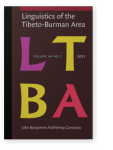Vol. 44:2 (2021) ► pp.157–182
Hearsay evidential marking strategy in Lhagang Tibetan
A case study on folktales and legends
This exploratory study focuses on the use of hearsay evidential marking in the course of storytelling in a Tibetic language, Lhagang Tibetan, combining a descriptive linguistic approach with a literary-theoretic analysis. Tibetic languages generally possess a morpho-syntactically encoded evidential-epistemic system, in which the hearsay evidential represents a non-first-hand information source. However, we find a random use of the hearsay evidential marker in the oral literature of Lhagang Tibetan, although it has been transmitted from one generation to another by storytellers. The article aims to provide a reasonable explanation for the use of the hearsay evidential in storytelling. It proposes that hearsay evidential marking reflects the speaker’s attitude towards the utterance to either avoid full responsibility for the utterance or enhance the utterance’s authenticity. The former objective principally appears in telling a story based on a weak memory of the story; the latter appears in telling a legend. This explanation is supported by oral literature theory, especially the arguments regarding the difference between folktales and legends.
Article outline
- 1.Introduction
- 2.Background and research question
- 2.1Basic description of the hearsay marking of Lhagang Tibetan
- 2.2Research question
- 3.Description of the hearsay evidential in Lhagang Tibetan
- 3.1The use of the hearsay evidential
- 3.2The hearsay evidential in contexts
- 4.Discussion
- 4.1Presence of hearsay evidential marking
- 4.2Absence of hearsay evidential marking
- 4.3Interpretation
- 5.Conclusion
- Acknowledgements
- Notes
- Abbreviations
-
References
